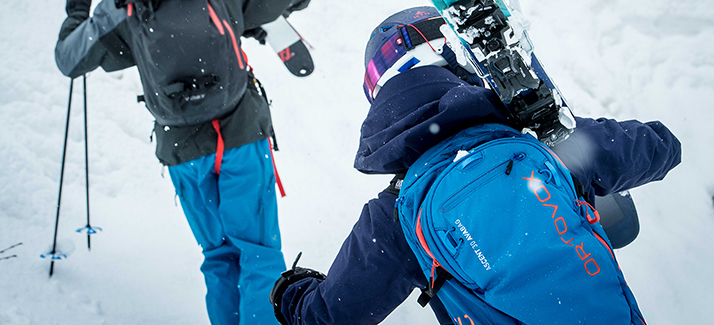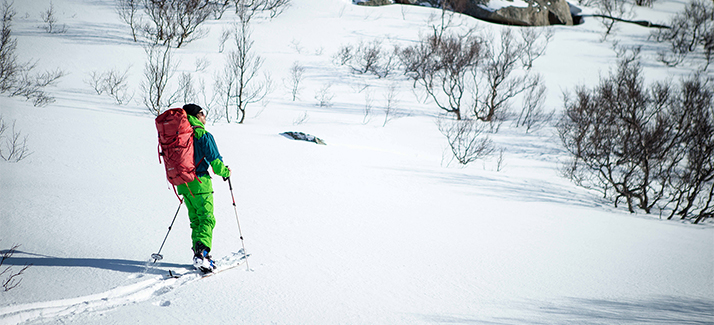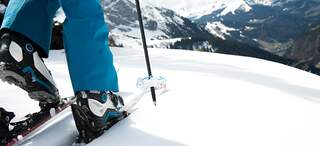HOW TO CHOOSE A BACKCOUNTRY BACKPACK
A backpack carries everything you need to stay alive in the backcountry. Choose yours wisely. Backcountry backpacks differ slightly from traditional hiking or day packs, so it’s important you find a comfortable, well-fitting pack for your adventures. Not only will backcountry packs have a separate compartment for your avalanche safety gear making it easy to access in the event of a slide, they’ll have specific straps to allow you to more easily carry your skis and snowboard when hiking uphill.
Size
Choosing the right size for your backcountry backpack is crucial, as it directly depends on the length of your trip and the amount of gear you plan to carry. Backpack capacity is typically measured in litres, and selecting the appropriate volume ensures you have enough space for essentials without carrying unnecessary weight.
For short outings, such as lift-served backcountry days or heli-riding, a smaller pack is ideal. These trips usually require minimal gear, so you won’t need a bulky rucksack weighing you down.
- 10–20 litres:
- Perfect for lift-served backcountry, heli-riding, or single-day adventures where you only need the basics.
If your plans involve longer day tours or you expect variable weather, you’ll want a bit more space to accommodate extra layers, food, and safety gear.
- 20–35 litres:
- A great choice for extended day tours, especially when you might face changing conditions and need to carry more supplies.
For overnight trips or hut-to-hut touring, you’ll need to pack additional clothing, a sleeping bag, and perhaps some cooking equipment. This calls for a larger backpack.
- 30–55 litres:
- Suitable for hut tours or overnight trips where you need to carry more gear and possibly some lightweight camping equipment.
When embarking on multi-day expeditions that require a tent, cooking gear, and glacier travel equipment, you’ll need a high-capacity pack to fit all your essentials comfortably.
- 60–70 litres:
- Necessary for longer backcountry trips involving camping, cooking, and glacier travel, where both volume and organisation are key.
Selecting the right backpack size will help you stay organised, comfortable, and prepared for any adventure the backcountry throws your way.
Fit
A well-fitting backcountry backpack is essential for comfort and performance during long days in the mountains. The right fit ensures you can wear your pack all day without discomfort or distraction. One of the most important factors to consider is the length of the pack and how it sits against your torso. Packs come in different torso lengths, so it’s crucial to match the pack size to your body for optimal weight distribution and support.
Steps to Ensure a Proper Fit:
- Test with Weight:
- Before committing to a pack, load it up with weight in the compartments. This simulates real-world conditions and helps you assess how the pack feels when fully packed.
- Adjust All Straps:
- Fit the pack to your body by tightening and loosening all the straps and the waistbelt. The waistbelt should sit comfortably on your hips, taking most of the load off your shoulders.
- Check Torso Length:
- Make sure the pack’s torso length matches your own. A pack that’s too long or too short can cause discomfort and affect your balance.
- Move Around:
- Walk, bend, and move as you would on the trail to ensure the pack stays secure and comfortable during activity.
Taking the time to properly fit your backpack will help prevent soreness and fatigue, making your backcountry adventures more enjoyable and safe.
Airbags
Avalanche airbags are a critical safety feature to consider when choosing a backcountry backpack, especially if you plan to travel in avalanche-prone terrain. These systems are engineered to keep you closer to the snow’s surface during an avalanche, increasing your chances of survival.
When an avalanche occurs, deploying an airbag rapidly inflates it, increasing your overall volume. This makes it more likely that you’ll remain on or near the surface of the moving snow, rather than being buried deep within the avalanche debris.
Key Points About Avalanche Airbags:
- Purpose:
- Designed to help keep you as high as possible in the snowpack during an avalanche by increasing your volume.
- Effectiveness:
- When properly worn and deployed, airbag packs have been shown to improve survival rates for those caught in avalanches.
- Limitations:
- It’s important to remember that while avalanche airbags can increase your chances of survival, they do not guarantee it. Safe decision-making and avalanche training remain essential.
Choosing a pack with an integrated airbag system can be a valuable addition to your backcountry safety toolkit, but it should always be used alongside other avalanche safety gear and knowledge.
Avalung®
If you’re venturing into the backcountry, choosing a backpack equipped with an Avalung® can significantly increase your chances of survival if you’re caught and buried in an avalanche. The Avalung® is a unique piece of safety equipment designed to help you breathe while trapped under snow, buying crucial time for rescuers to reach you.
How the Avalung® Works:
- The Avalung® allows you to draw in oxygen from the snowpack through a mouthpiece, using a system of one-way valves and a respiratory tube.
- When you exhale, the system directs carbon dioxide away from your face and out to the side or behind your body, preventing the buildup of CO₂ around your mouth and nose.
- By separating inhaled fresh air from exhaled stale air, it delays asphyxiation and reduces the risk of forming an “ice mask” (a frozen barrier of exhaled moisture that can block airways).
Key Benefits:
- Extends Survival Time:
- Studies have shown that the Avalung® can increase survival time under snow from about 10–15 minutes (without an air pocket) to up to 58–90 minutes, depending on conditions and device use.
- Reduces CO₂ Buildup:
- By channeling exhaled air away from your face, the Avalung® prevents the dangerous accumulation of carbon dioxide that often leads to suffocation in avalanche burials.
- Helps Maintain an Open Airway:
- The system can also minimise snow packing and ice formation around the face, making it easier to keep breathing while buried.
Practical Considerations:
- The Avalung® must be in your mouth before or during the avalanche for it to be effective—this requires practice and presence of mind in hazardous situations.
- Some backpacks have the Avalung® integrated into the shoulder strap for easier access, but users must ensure the tube isn’t compressed or obstructed by clothing or pack straps.
- While the Avalung® can prolong survival, it does not replace the need for rapid rescue and does not protect against trauma or hypothermia.
Choosing a pack with Avalung® technology is a smart addition to your avalanche safety gear, but always remember that it’s just one part of a comprehensive approach to backcountry safety. Avalanche education, careful route selection, and rescue skills remain essential.
Other Features
When choosing a backcountry backpack, a few extra features can greatly enhance your experience and functionality on the mountain. These details might seem minor, but they often make a noticeable difference in comfort, convenience, and overall safety during your adventures.
Hydration Compatibility
Staying hydrated is crucial in the backcountry. Many packs now come equipped with a dedicated compartment and exit port designed specifically for a hydration bladder. This setup protects your bladder and ensures easy access to water while you’re on the move—no need to stop or unpack to take a sip.
Back and Side Zippers
Access points on your backpack can make a big difference. Packs with back and side zippers allow you to reach items at the bottom or sides without having to empty everything from the main opening. These extra zippers save precious time and reduce frustration, especially when you need to grab gear in a pinch.
Ice Axe Carry Loops
If your adventures take you onto glaciated terrain or require technical climbing, look for a backpack with reinforced loops at the front or bottom. These loops make it simple to securely attach ice axes or other alpine tools, keeping them safe and out of the way when not in use.
Daisy Chain Gear Loops
Daisy chains are often stitched along the exterior of the pack and provide versatile attachment points for extra gear. You can use them to clip on climbing hardware, carabiners, or even strap crampons to your pack for easy access on steep or icy ascents.
Helmet Carry
A dedicated helmet carry pouch or flap is an excellent addition for skiers and climbers alike. This feature keeps your helmet secure—either tucked flat or held in a pocket—while you’re not wearing it, preventing it from bouncing or snagging as you move.
By considering these extra features, you’ll ensure your pack is equipped for a wide range of backcountry challenges and adventures. These small innovations go a long way toward making your time in the mountains safer, easier, and more enjoyable.
Backcountry Backpacks FAQs
Choose size based on trip length and gear: 10–20L for short outings or lift-served days, 20–35L for longer day tours, 30–55L for overnight hut trips, and 60–70L for multi-day adventures needing extra equipment or winter gear.
Look for avalanche gear compartments, ski/snowboard carry straps, helmet and ice axe carry, and accessible zippers or side pockets. Well-designed packs make it easy to organise and quickly access essentials in demanding situations.
Fit is crucial—choose a size that matches your torso length, with an adjustable, padded hip belt and shoulder straps for comfort on long days. Try loaded packs in-store for the most accurate fit.
Balance weight and durability; aim for a lightweight pack with reinforced materials to withstand demanding winter use. Sub-1.5kg is considered light, but ensure the pack supports your full kit and conditions.
Quick access to safety gear is vital in emergencies. Choose packs with separate avalanche gear compartments and multiple access zips or pockets for fast retrieval of essentials like your probe or shovel.
Related Articles

Let us know you agree to cookies
We use marketing, analytical and functional cookies as well as similar technologies to give you the best experience. Third parties, including social media platforms, often place tracking cookies on our site to show you personalised adverts outside of our website.
We store your cookie preferences for two years and you can edit your preferences via ‘manage cookies’ or through the cookie policy at the bottom of every page. For more information, please see our cookie policy.




